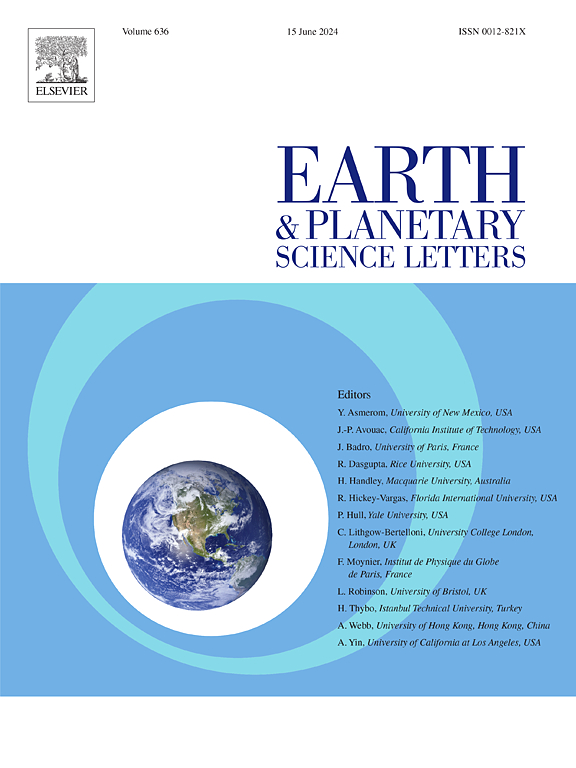Snapshots of magmatic evolution revealed by zircon depth profiling
IF 4.8
1区 地球科学
Q1 GEOCHEMISTRY & GEOPHYSICS
引用次数: 0
Abstract
Upper-crustal granitoids are a late-stage product of crustal differentiation. This last stage in the evolution has been proposed to be the key interval that governs volcanic eruptions, ore formation, and fluid migration. Though numerous techniques have been employed to understand the evolution of late-stage felsic magmas, there remains little agreement regarding their crystallization histories. Here we use laser ablation depth profiling of zircon trace elements to probe the thermochemical evolution of well-characterized granitoid rocks from the Tuolumne Intrusive Suite (CA, USA). In combination with titanite trace-element data, we can determine the T-X trajectory of the magmatic system during zircon growth at the latest stage of crystallization. Our data also allows for a robust empirical calibration of the widely used Ti-in-zircon thermometer arising from the onset of titanite crystallization captured in zircon rims. These data show that Tuolumne zircon growth occurred at an aTiO2 of 0.4–0.5, which is lower than many previous estimates. We further model zircon growth up- and down-temperature from titanite saturation, and document extended thermochemical growth records preserved in zircons from these upper-crustal melts. The calculated temperatures are consistent with zircon growth from 775 to 625 °C, indicating that zircon growth occurred over a wide temperature range down to, or potentially below, the water-saturated granite solidus. These findings provide empirically-calibrated values for use in other Ti-in-zircon and Zr-in-titanite temperature calculations, particularly to understand late-stage, low-temperature melts in granitoid systems.
锆石深度剖面显示的岩浆演化快照
上地壳花岗岩是地壳分异的后期产物。演化的最后阶段被认为是火山喷发、矿石形成和流体迁移的关键阶段。尽管已经采用了许多技术来了解晚期长岩岩浆的演化过程,但对其结晶历史的认识仍鲜有一致。在这里,我们利用锆石痕量元素的激光烧蚀深度剖面探测了来自图卢姆侵入岩组(美国加利福尼亚州)的特征良好的花岗岩岩石的热化学演化。结合榍石痕量元素数据,我们可以确定锆石生长过程中岩浆系统在结晶最新阶段的T-X轨迹。我们的数据还可以根据锆石边缘捕捉到的榍石结晶的起始点,对广泛使用的钛锆石温度计进行可靠的经验校准。这些数据表明,Tuolumne锆石的生长发生在二氧化钛a值为0.4-0.5时,这比之前的许多估计值都要低。我们进一步模拟了钛铁矿饱和后锆石生长的升温和降温过程,并记录了保存在这些上地壳熔体锆石中的扩展热化学生长记录。计算得出的温度与锆石在 775 ℃ 至 625 ℃ 之间的生长相一致,表明锆石生长的温度范围很广,一直到或可能低于水饱和花岗岩固结温度。这些发现提供了经验校准值,可用于其他钛-锆石和锆-钛铁矿的温度计算,特别是用于了解花岗岩体系中的晚期低温熔体。
本文章由计算机程序翻译,如有差异,请以英文原文为准。
求助全文
约1分钟内获得全文
求助全文
来源期刊

Earth and Planetary Science Letters
地学-地球化学与地球物理
CiteScore
10.30
自引率
5.70%
发文量
475
审稿时长
2.8 months
期刊介绍:
Earth and Planetary Science Letters (EPSL) is a leading journal for researchers across the entire Earth and planetary sciences community. It publishes concise, exciting, high-impact articles ("Letters") of broad interest. Its focus is on physical and chemical processes, the evolution and general properties of the Earth and planets - from their deep interiors to their atmospheres. EPSL also includes a Frontiers section, featuring invited high-profile synthesis articles by leading experts on timely topics to bring cutting-edge research to the wider community.
 求助内容:
求助内容: 应助结果提醒方式:
应助结果提醒方式:


